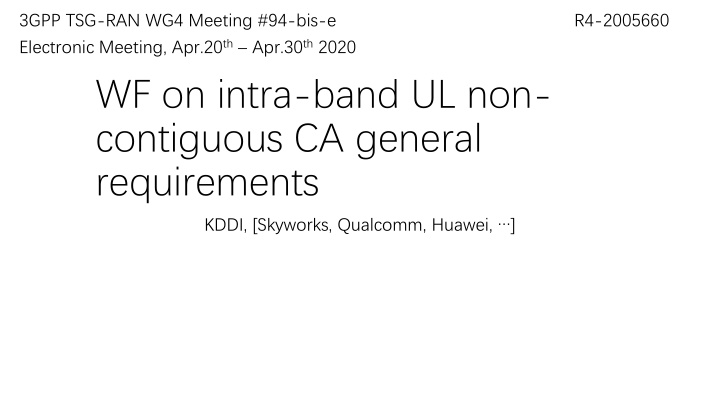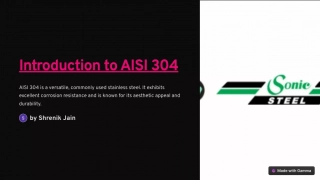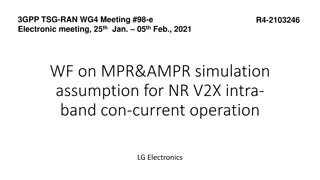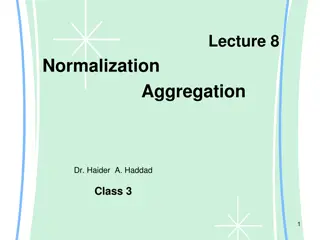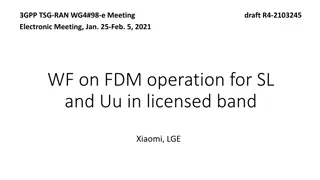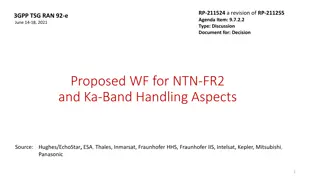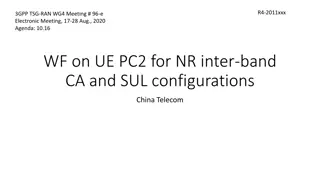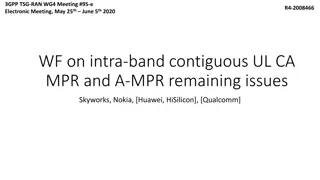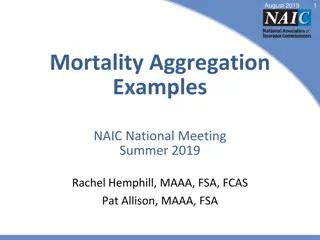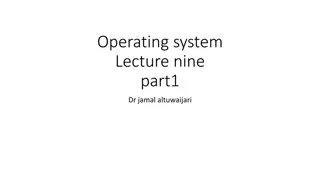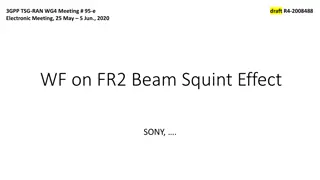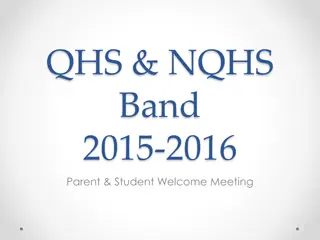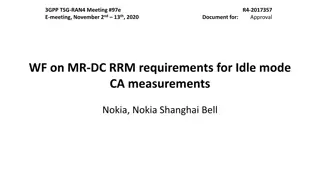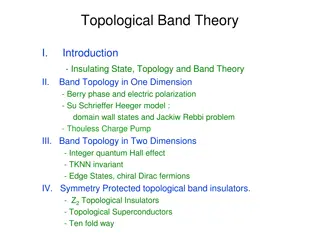Requirements for Intra-band UL Non-contiguous Carrier Aggregation
Meeting #94-bis-eElectronic introduced general requirements for intra-band uplink non-contiguous carrier aggregation. Participants included KDDI, Skyworks, Qualcomm, and Huawei.
Download Presentation

Please find below an Image/Link to download the presentation.
The content on the website is provided AS IS for your information and personal use only. It may not be sold, licensed, or shared on other websites without obtaining consent from the author.If you encounter any issues during the download, it is possible that the publisher has removed the file from their server.
You are allowed to download the files provided on this website for personal or commercial use, subject to the condition that they are used lawfully. All files are the property of their respective owners.
The content on the website is provided AS IS for your information and personal use only. It may not be sold, licensed, or shared on other websites without obtaining consent from the author.
E N D
Presentation Transcript
3GPP TSG-RAN WG4 Meeting #94-bis-e Electronic Meeting, Apr.20th Apr.30th2020 R4-2005660 WF on intra-band UL non- contiguous CA general requirements KDDI, [Skyworks, Qualcomm, Huawei, ]
Background UL NC CA requested configurations in Rel-16 are as follows n41(2A), n77(2A), n78(2A) The number of UL subcarrier allowed in Rel-16 is two Comparison of different PA/LO architectures [2] 1PA/1LO: instantaneous TX bandwidth: ~200MHz Number of TX chain: 1 (2TX to support UL MIMO) 2PA/2LO: instantaneous TX bandwidth: >200MHz can be supported (and below obviously) Number of TX chain: 2 (4TX to support UL MIMO) 1PA/2LO has the same situation as 2PA/2LO. However, it is not recommended for the following reasons inherent power backoff (insertion loss) issue [3] One possible solution is to put 3dB combiners and switches in the PA requires extra complexity and may still be limited for UL MIMO due to limited number of TX chains Instantaneous TX bandwidth: frequency range from the lower bound of lower CC to the upper bound of upper CC.
WF of UE architecture Only consider 2PA/2LO case for intra-band UL NC CA in Rel-16. According to spectrum allocation information from interested operators in [1], most cases cannot apply 1PA/1LO architecture which has limitation of instantaneous TX bandwidth as up to 200MHz. 1PA/1LO architecture can apply to n41(2A), however there are no comments on UE architecture for n41(2A) so far. 1PA/1LO case can be discussed based on operator requests. Since 1PA/1LO architecture is an essential case and can apply to most refarming bands, discussion of general requirements in this WF also consider 1PA/1LO.
WF of ACLR No ACLR requirement if Wgap < max(CC1BW, CC2BW) to prevent excessive in-band emission with other sub-block. For 1PA/1LO architecture, exception should be allowed while the leakage and image falling on a frequency belonging to another licensee
WF of SEM Where two masks overlap, the most relaxed limit is used. Composite spectrum emission mask applies to frequencies up to fOOB starting from the edges of the sub-blocks If for some frequency an individual sub-block spectrum emission mask overlaps with the bandwidth of another sub-block, the emission mask does not apply for that frequency. For 1PA/1LO architecture, exception should be allowed while the leakage and image falling on a frequency belonging to another licensee FOOB1 No SEM No SEM FOOB2 Shared region uses relaxed limit Spurious Region Spurious Region Composite SEM
WF of spurious emission The spurious emission limits apply for the frequency ranges that are more than FOOB(MHz) from the edge of the aggregated channel bandwidth for frequencies in the gap and out of the gap. For frequencies FOOBgreater than FOOB, the spurious emission requirements in Table 6.5.3-2 (TS38.101-1) are applicable No spurious requirement applies in the gap if Wgap < FOOB1+ FOOB2, otherwise only composite SEM FOOB1 FOOB2 No SEM FOOB2 FOOB1 No SEM Spurious Region Spurious Region Spurious Region
WF of synchronization of n77/n78/n79 UL NC CA follows Rel-16 s assumption that n77 is synchronized with n79. Async operation is specified in Rel-16 for n78 only UE with special filter assumption. Async operation can be discussed based on operator request. The band n78 filter provides some protection from a single CC TX noise but this may not be sufficient for IMDs (IMD5 and 7). We need to clarify max TX BW for n78(2A) to check filters and IMDs if n78 and n79 are Asynchronous
WF of Radio altimeter protection No additional requirement for radio altimeter protection at 4200MHz 4400MHz.
WF of MIMO supporting for UL NC CA Requirements for MIMO related signalling If UL MIMO support is signalled for nXXA it cannot be supported for nXX(2A) if dual-PA is signalled under current signalling MIMO supporting with 4TX for 2PA UL NC CA should not be excluded Send LS to RAN2
Reference [1] R4-2002812, WF on Intra-band Non-contiguous ULCA TX Architectures and Issues , Qualcomm, Skyworks, KDDI [2] R4-2005100, Email discussion summary for RAN4#94be_#14_NR_RF_FR1_Part_1 , Huawei [3] R4-2004467, FR1 Intra-band Non-contiguous ULCA , Qualcomm
